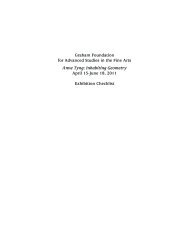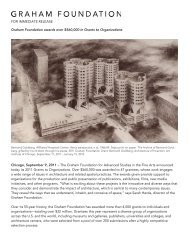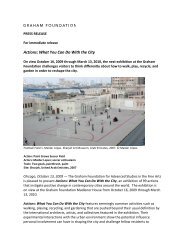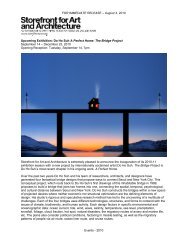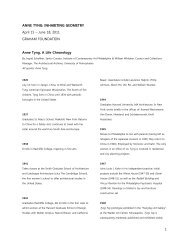Nine Clouds of Architecture, Essay by Emmanuel Petit - Graham ...
Nine Clouds of Architecture, Essay by Emmanuel Petit - Graham ...
Nine Clouds of Architecture, Essay by Emmanuel Petit - Graham ...
Create successful ePaper yourself
Turn your PDF publications into a flip-book with our unique Google optimized e-Paper software.
Kingdom <strong>of</strong> Atlantis, axonometric, ink on vellum, 36 x 24.25", 1976-82<br />
architects such as Holabird, Burnham, Jenney, and<br />
Root, Tigerman exploited the implications <strong>of</strong> the literary<br />
motif <strong>of</strong> “clouds” in architecture, both visually<br />
and philosophically. On the visual level, he painted<br />
the ceiling <strong>of</strong> the Little House with the trompe l’œil<br />
<strong>of</strong> a cloudy sky as an implicit reference to René<br />
Magritte’s surrealist paintings —“Human Condition”<br />
(1935), the “Call <strong>of</strong> the Summits” (1942), “Personal<br />
Values” (1952), or the painted murals “The Enchanted<br />
Realm” <strong>of</strong> clouds in the grand salon <strong>of</strong> the Casino in<br />
Knokke-Heist / Le Zoute (1953). For Tigerman, as<br />
for Magritte, the illusionistic visual device <strong>of</strong> painted<br />
clouds suggested the paradoxical relationship between<br />
the enclosed and finite space <strong>of</strong> architecture and its<br />
“exterior” as the infinite space <strong>of</strong> the imagination. For<br />
Tigerman and Magritte, art and architecture can only<br />
signify through interpretation, association and allusion,<br />
yet cannot inherently embody ideas. In order to<br />
self-consciously communicate this restriction, both<br />
artists have <strong>of</strong>ten reverted to irony.<br />
The motif <strong>of</strong> Tigerman’s mural goes back to its literary<br />
use in the Aristophanic comedy, The <strong>Clouds</strong>. The<br />
play not only lampooned the sophist tendencies <strong>of</strong><br />
Ancient Athens around Socrates, but also ridiculed a<br />
number <strong>of</strong> initiation rites into the intellectual life <strong>of</strong> a<br />
public person. The <strong>Clouds</strong> was an irreverent satire <strong>of</strong><br />
pompous academia and an example <strong>of</strong> self-referential<br />
literature; indeed, towards the middle <strong>of</strong> the play, the<br />
playwright himself took the stage and chastised the<br />
audience for their lack <strong>of</strong> humor. The satiric thrust<br />
was made explicit <strong>by</strong> the presence <strong>of</strong> the accompanying<br />
“Chorus <strong>of</strong> <strong>Clouds</strong>,” which stood for the divine




